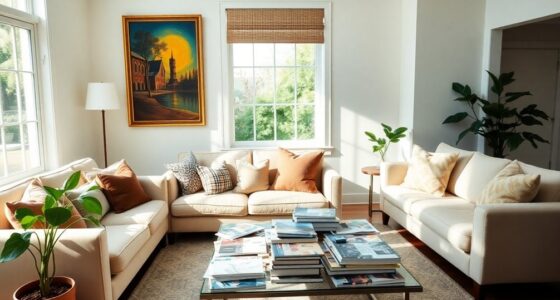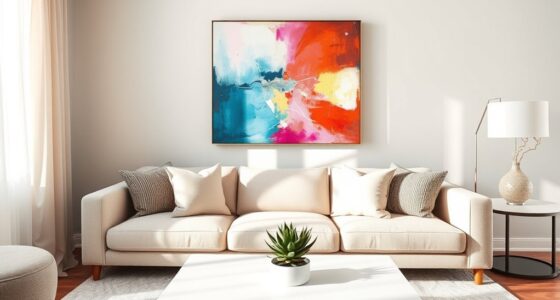To decorate with sustainable materials, start by choosing reclaimed or recycled wood for focal pieces and opt for eco-friendly flooring like bamboo, cork, or linoleum. Use organic textiles such as linen, cotton, and hemp for furniture and decor, and incorporate natural dyes for vibrant colors. Select low VOC paints and energy-efficient lighting like LEDs or solar fixtures. Upcycled decor and plant-based finishes can add character while supporting the environment. Discover more ways to create stylish, eco-conscious spaces with sustainable materials.
Key Takeaways
- Incorporate reclaimed, recycled, and eco-friendly materials like reclaimed wood, bamboo flooring, and natural linoleum for sustainable decor.
- Use organic textiles such as linen, hemp, and cotton with plant-based dyes to create eco-conscious, stylish textiles.
- Choose VOC-free paints, low-impact finishes, and solar or LED lighting to reduce indoor pollution and energy consumption.
- Integrate upcycled decor items like vintage furniture, salvaged metal, and repurposed accessories to minimize waste.
- Maintain sustainable materials properly with gentle cleaning and mindful care to extend their lifespan and environmental benefits.
Reclaimed and Recycled Wood Products

Reclaimed and recycled wood products are an excellent choice for sustainable decorating because they give new life to old materials while reducing waste. By incorporating these pieces, you add a touch of vintage charm that’s both warm and authentic. The weathered textures and unique grains bring character and history to your space, emphasizing a sense of timelessness. Plus, reclaimed wood fits perfectly with an industrial aesthetic, blending raw, rugged elements with modern design. Using recycled wood not only minimizes environmental impact but also creates a focal point that’s both stylish and eco-friendly. Incorporating vertical storage solutions can further maximize space and keep your environment organized while highlighting the beauty of reclaimed materials. Whether you choose a reclaimed wood table, shelving, or accent pieces, you’ll enjoy a distinctive look that celebrates sustainability. Embrace these materials to add depth and personality to your home decor.
Organic and Natural Textiles
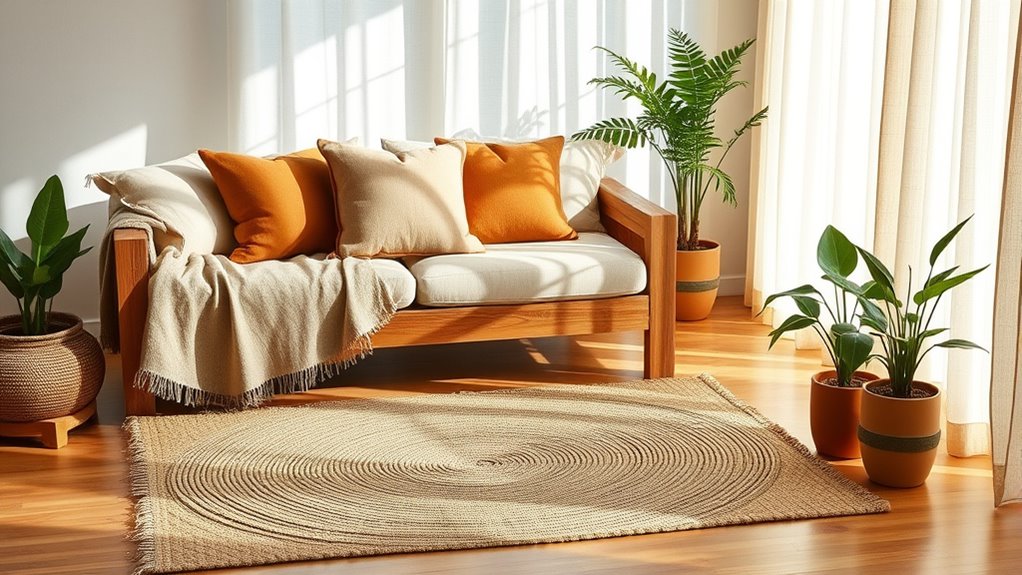
Organic and natural textiles come from eco-friendly fiber sources that reduce environmental impact. These materials are breathable and comfortable, making them great choices for your home. Plus, using organic dyes and colors helps you create vibrant, sustainable decor without harmful chemicals. Incorporating natural materials like linen and cotton further enhances the eco-friendly aspect of your decor choices.
Eco-Friendly Fiber Sources
Choosing eco-friendly fiber sources means opting for textiles made from natural or organic materials that support sustainable farming and reduce environmental impact. Biodegradable fibers, like hemp, linen, and organic cotton, break down naturally, minimizing waste in landfills. Plant-based textiles are renewable and require fewer chemicals and pesticides during cultivation, making them a healthier choice for the environment. These fibers often have a lower carbon footprint compared to synthetic options, helping you reduce your ecological impact. By selecting sustainable fibers, you guarantee your decorating choices promote conservation and eco-conscious living. Incorporating materials such as jute or bamboo further enhances your efforts, as these are fast-growing, renewable resources. Embracing sustainable farming practices can improve the overall ecological benefits of your material choices, ensuring they are truly environmentally friendly. Choosing these eco-friendly fiber sources aligns your decor with eco-awareness while maintaining durability and aesthetic appeal.
Breathable Textile Benefits
Because natural and organic textiles are inherently breathable, they help regulate indoor temperatures and improve air quality. This airflow enhancement keeps your space comfortable and fresh. Organic fabrics like cotton and linen facilitate moisture regulation, preventing excess humidity and dampness. Imagine:
- Soft linen curtains allowing gentle breezes to flow through.
- Cotton throws that wick away sweat during warm nights.
- Wool rugs that absorb moisture without feeling damp.
- Hemp cushions that promote air circulation around your seating area.
These textiles work together to create a healthier environment by reducing stuffiness and humidity. Their breathability supports better airflow and moisture management, making your space more comfortable and sustainable. Incorporating organic and natural textiles truly elevates your decor’s comfort and eco-friendliness.
Additionally, choosing breathable textiles made from natural fibers can reduce the need for artificial climate control, further enhancing your home’s sustainability.
Organic Dyes and Colors
When it comes to enhancing the beauty of sustainable textiles, the use of organic dyes and colors plays a vital role. Natural dyeing techniques allow you to create vibrant, earthy hues using plant-based materials, reducing chemical reliance. You can explore a variety of plant-based color palettes, from deep indigos derived from indigo plants to warm yellows from turmeric. These dyes not only produce stunning, unique shades but also guarantee your textiles remain eco-friendly and safe. By choosing organic dyes, you support sustainable practices and avoid harmful synthetic dyes that can harm the environment. Embracing natural dyeing techniques lets you infuse your textiles with rich, authentic colors while maintaining your commitment to eco-conscious decoration. Additionally, understanding the types of dyes and their application methods can help you achieve better results and longer-lasting colors.
Eco-Friendly Paints and Finishes
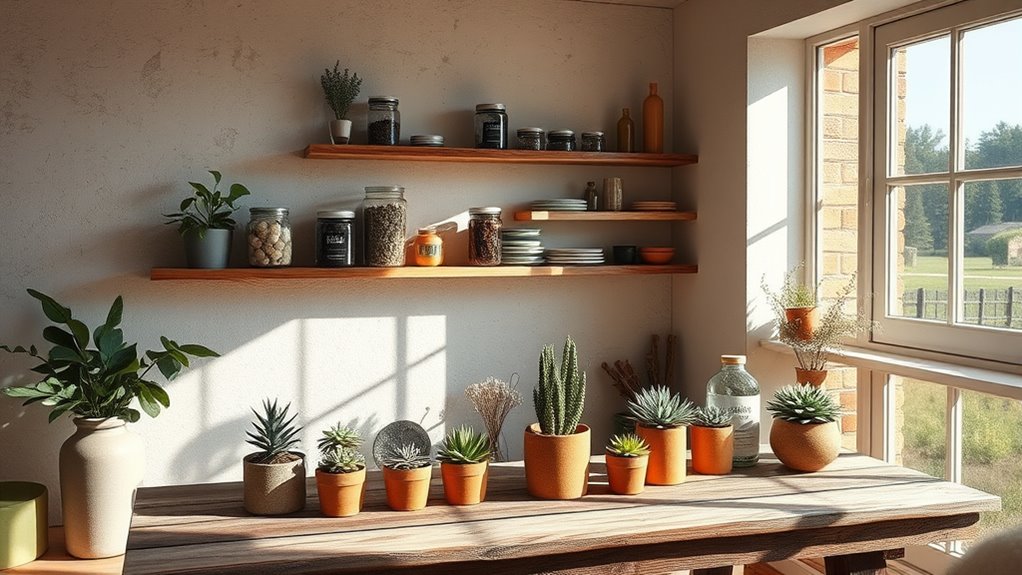
Eco-friendly paints and finishes offer a sustainable alternative to traditional products by reducing harmful chemicals and environmental impact. By choosing VOC free finishes and low VOC paints, you minimize indoor air pollution and create healthier living spaces. Imagine:
- A smooth wall coated with a low VOC paint, free of harsh fumes.
- A glossy finish made with VOC free finishes that enhance furniture durability.
- A subtle matte hue that stays vibrant without emitting toxic gases.
- A natural sealant that protects wood without compromising air quality.
- Selecting paints with low or zero VOC content ensures safer indoor environments for your family and the planet.
These options help you decorate responsibly, knowing you’re reducing your carbon footprint. Eco-friendly paints and finishes not only beautify your space but also promote a healthier environment for you and your loved ones.
Sustainable Flooring Options
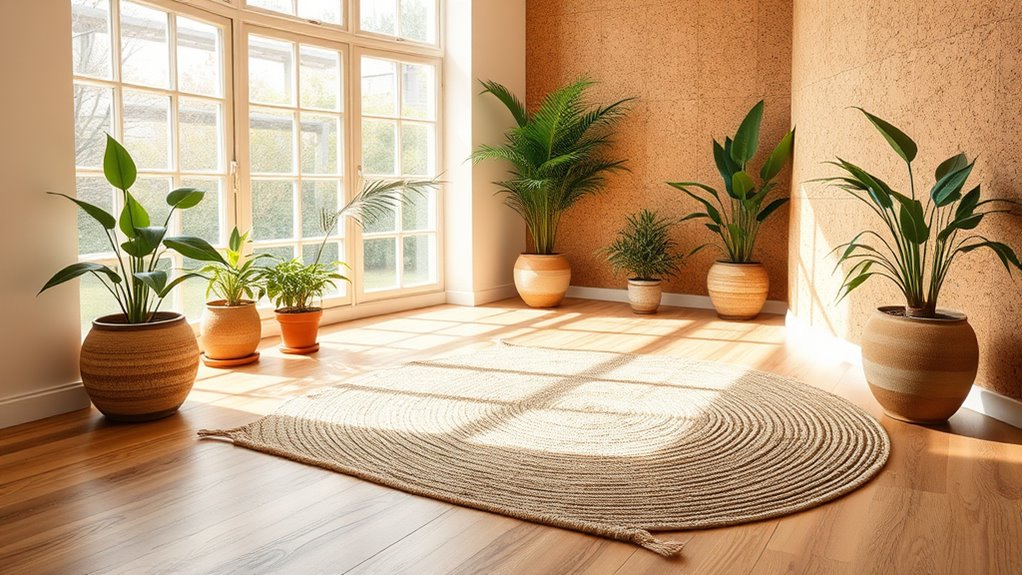
When choosing sustainable flooring, you should consider eco-friendly materials that balance style and function. Think about durability and how much maintenance each option requires to keep your space looking great. Also, check the cost and availability to make certain your choice fits your budget and timeline. Incorporating sound design techniques can even enhance the acoustic environment within your space, creating a more comfortable atmosphere.
Eco-Friendly Material Choices
Choosing sustainable flooring options can considerably reduce your home’s environmental impact while enhancing its aesthetic appeal. When selecting eco-friendly materials, consider options like bamboo, cork, reclaimed wood, and linoleum, which are renewable and biodegradable. Imagine walking on:
- Bamboo flooring, harvested quickly from fast-growing plants.
- Cork, made from the bark of cork oak trees, which regrows naturally.
- Reclaimed wood, giving new life to salvaged planks.
- Linoleum, crafted from natural oils, resins, and biodegradable packaging materials.
These choices align with recycling initiatives by repurposing old materials and reducing waste. Color accuracy and contrast ratios are essential factors that can influence the overall visual experience of your space, ensuring that the environment is both beautiful and functional. By opting for such flooring, you contribute to a greener future while creating a stylish, sustainable space that reflects your commitment to eco-friendly living.
Durability and Maintenance
Sustainable flooring options are designed to withstand daily wear and tear, making them practical choices for long-term use. To maintain their durability, you should follow proper cleaning routines tailored to each material. Regular sweeping and gentle mopping prevent dirt buildup that can cause scratches or damage over time. For instance, bamboo floors require soft cloths, while cork needs moisture control. Additionally, understanding digital literacy programs can help seniors engage with modern maintenance tools and tips. Below is a table summarizing maintenance tips for common sustainable flooring options:
| Flooring Type | Cleaning Routine | Long-Term Wear Tips |
|---|---|---|
| Bamboo | Sweep, damp mop | Avoid excess water |
| Cork | Light vacuuming | Use furniture pads |
| Reclaimed Wood | Gentle cleaning | Prevent scratches |
| Linoleum | Mild soap, water | Protect from UV rays |
Sticking to these routines helps your floors last longer and stay eco-friendly.
Cost and Availability
Ever wondered how the costs and availability of sustainable flooring options compare to traditional choices? While eco-friendly flooring can sometimes seem pricier, the price fluctuation depends heavily on the supply chain stability. Here’s what you might encounter:
- Bamboo flooring: Usually affordable, but shortages can drive prices up during high demand.
- Reclaimed wood: Limited supply means higher costs and longer wait times.
- Cork: Consistent availability, but quality varies, affecting price.
- Linoleum: Generally affordable and widely available, though certain colors or patterns may be limited.
- The durability of wood-based flooring can influence long-term costs and maintenance needs, affecting overall value.
Availability fluctuates based on raw material access and global supply chain disruptions. Careful planning helps you find sustainable options that fit your budget and ensure timely installation.
Green Lighting Solutions
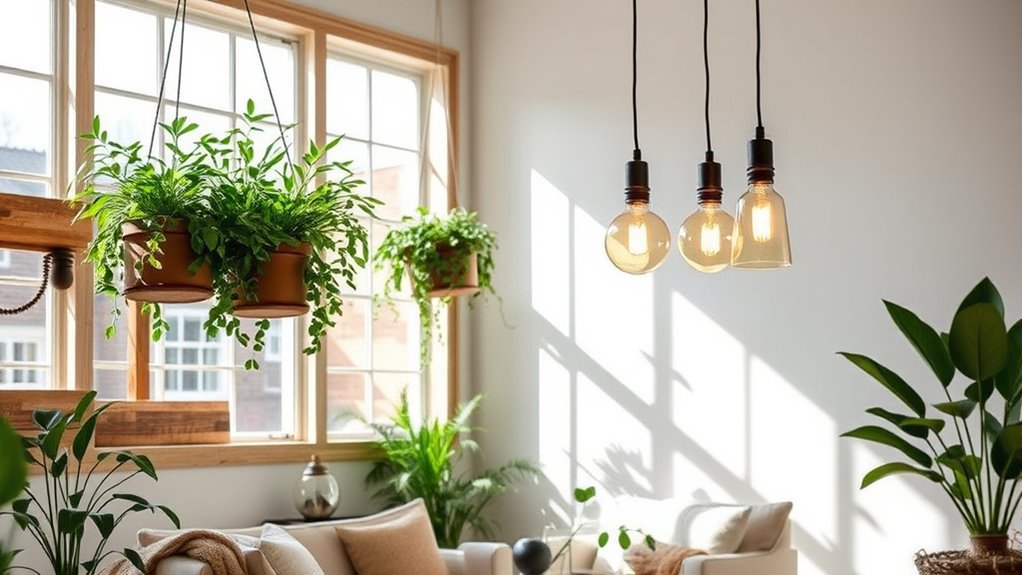
Green lighting solutions are becoming increasingly popular as people look for ways to reduce their environmental impact. You can start by choosing solar-powered fixtures that harness sunlight, reducing reliance on grid electricity. These fixtures are easy to install and ideal for outdoor spaces like gardens or pathways. Inside, LED lighting options provide energy-efficient illumination with a long lifespan, consuming markedly less power than traditional bulbs. By switching to LEDs, you cut down on energy waste and lower your carbon footprint. Combining solar-powered fixtures with LED lights creates a sustainable lighting system that’s both eco-friendly and cost-effective. You’ll enjoy bright, reliable lighting while making a positive impact on the environment. These solutions are simple upgrades that promote sustainability without sacrificing style or functionality.
Upcycled Decor and Accessories

Upcycling transforms everyday items into stylish decor and accessories, giving new life to materials that might otherwise be discarded. This approach adds vintage charm and allows for artistic expression in your space. Imagine a coffee table made from reclaimed wood, showcasing rich grains and a weathered finish. Or picture hanging planters crafted from old teacups, blending nostalgia with greenery. You might also repurpose vintage suitcases as storage or side tables, adding character and history. Lastly, consider jewelry made from scrap metal or fabric scraps, turning scraps into unique accessories. These upcycled decor pieces not only reduce waste but also create a personalized, charming environment. Embrace upcycled decor for a sustainable, creative touch that celebrates both vintage appeal and your artistic vision.
Plant-Based and Non-Toxic Materials
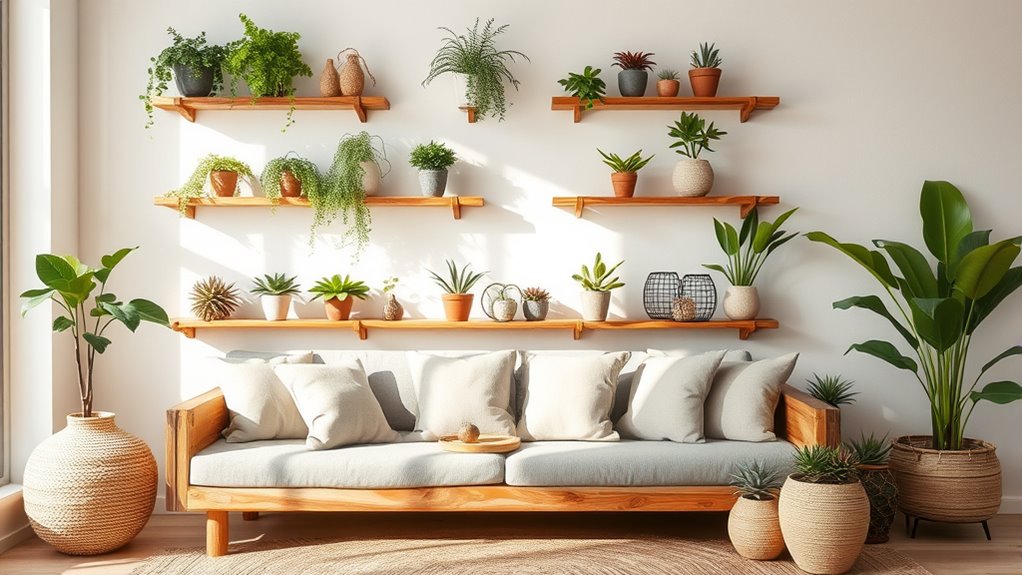
Building on the charm of upcycled decor, incorporating plant-based and non-toxic materials can further enhance your space’s sustainability. Choose furniture and accessories finished with non-toxic finishes to guarantee safer indoor air quality. Opt for paints and sealants made from plant-based dyes that are free from harmful chemicals, reducing your environmental impact. These natural dyes offer vibrant, earthy tones that add warmth and character to your decor. By selecting items crafted with non-toxic finishes and plant-based dyes, you create a healthier living environment while supporting eco-friendly practices. This approach not only minimizes your carbon footprint but also promotes safer spaces for you and your loved ones. Embrace these sustainable materials to make your home both beautiful and environmentally responsible.
Local and Artisanal Craftsmanship
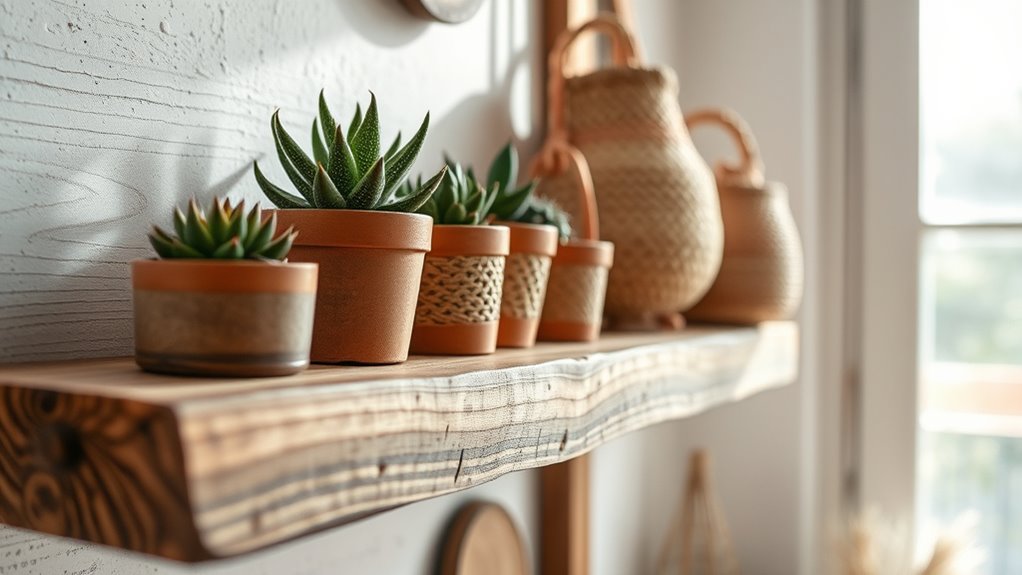
Choosing local and artisanal craftsmanship allows you to bring unique character and authenticity to your home while supporting small-scale producers. When you work with local artisans, you gain access to handcrafted techniques that showcase skill and tradition. Imagine a handcrafted wooden bowl with intricate carvings, or a woven textile with vibrant colors created by skilled hands. Visualize a ceramic vase shaped by local artisans, each piece telling a story. Or consider custom furniture made with sustainable woods, designed specifically for your space. These items embody craftsmanship and sustainability, making your décor more meaningful. By choosing these artisanal pieces, you not only elevate your space but also help preserve cultural heritage and promote eco-friendly practices.
Frequently Asked Questions
How Do I Verify the Sustainability Claims of Materials?
To verify the sustainability claims of materials, you should check for certification standards like FSC, LEED, or GREENGUARD, which guarantee they meet eco-friendly criteria. Also, ask for supply chain transparency to understand where and how materials are sourced. Research brands that provide detailed information about their sourcing and certifications, and don’t hesitate to contact suppliers directly for clarification. This way, you can confidently choose genuinely sustainable materials.
Are Sustainable Materials Cost-Effective Long-Term?
While it’s wise to contemplate the cost comparison of sustainable materials, they often prove to be quite cost-effective long-term. You might find that initial investment pays off through long-term savings, thanks to durability and reduced maintenance needs. Over time, sustainable options can help you save money and support eco-friendly choices, making them a smart, budget-conscious decision that benefits both your wallet and the environment.
Can Sustainable Decor Suit Modern Interior Styles?
You can definitely make sustainable decor fit modern interior styles. By choosing eco-friendly color palettes, you create a sleek, contemporary look while supporting sustainability. Incorporate natural texture integration through materials like reclaimed wood or bamboo to add depth and warmth. These elements seamlessly blend with modern design principles, making your space stylish and eco-conscious. So, sustainable decor isn’t just compatible; it can elevate your modern aesthetic effortlessly.
How Do I Ensure Durability With Eco-Friendly Products?
Think of eco-friendly products as a sturdy tree rooted in renewable sources, growing stronger over time. To guarantee durability, you should choose eco-friendly finishes that are resilient and age gracefully. Look for products crafted from renewable sources like bamboo or reclaimed wood, which naturally withstand wear. Proper maintenance, like gentle cleaning and avoiding harsh chemicals, helps these materials stand the test of time, making your space both beautiful and sustainable.
What Maintenance Practices Prolong Eco-Friendly Decor Lifespan?
To prolong your eco-friendly decor’s lifespan, you should regularly clean and inspect it for damage. Use eco-friendly finishes that protect surfaces without harmful chemicals, and apply natural preservation methods like beeswax or plant-based oils to maintain materials. Avoid harsh cleaners, and keep decor away from excessive moisture or direct sunlight. These practices guarantee your eco-conscious choices remain durable, beautiful, and sustainable over time.
Conclusion
By choosing sustainable materials, you’re not just decorating a space – you’re planting seeds of change that grow into a greener future. Every reclaimed wood piece, organic textile, or eco-friendly paint option you select is a drop of hope in a sea of environmental impact. Your choices have the power to transform your home into a sanctuary that nurtures the planet, proving that beautiful design and sustainability can walk hand in hand like a harmonious dance.



